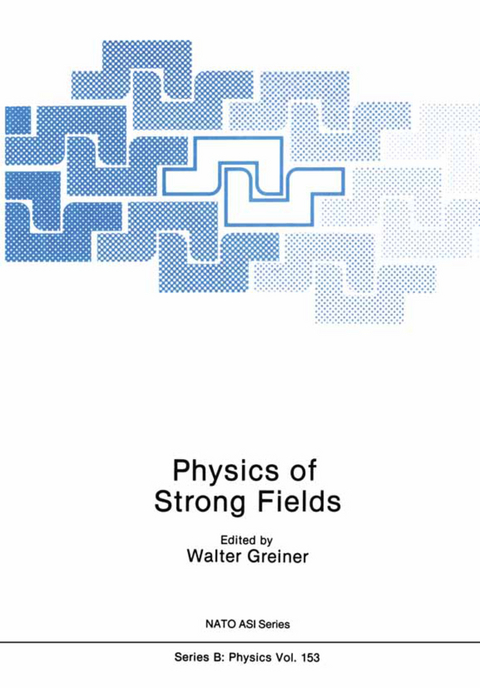
Physics of Strong Fields
Springer-Verlag New York Inc.
978-1-4612-9052-0 (ISBN)
Strong Fields in Perspective.- Status of Precision QED in Light and Heavy Atoms.- The Many Facets of the Dirac Vacuum.- Are the Positron Peaks Caused by Internal Electron-Positron Pair Conversion ?.- Atomic Clock Phenomena in Collisions of Very Heavy Ions.- Narrow Correlated Positron-Electron Peaks from Superheavy Collision Systems.- Investigation of Positron Line Emission in Heavy Ion Collisions with the EPOS-Spectrometer.- Special Aspects of the EPOS Experiments on Positron Emission from Superheavy Collision Systems.- Spectroscopy of Positrons from Heavy Ion-Atom Collisions.- Positron Emission from Subcritical Systems.- The Consequences of Sudden Rearrangements of Electronic Shells.- Are the GSI Events Caused by Particle Decay ?.- On the Possibility of New Particle Production in Heavy-Ion Collisions.- Quasiatomic Spectroscopy as a Tool for Deep Inelastic Collisions.- Positrons and Electrons Emitted in Elastic and Dissipative Heavy Ion Collisions.- Do Nucleons Dissolve in Giant Nuclei ?.- Vacuum Vibrations.- Quantum Mechanical Treatment of Heavy-Ion Collisions.- Nuclear Contact Times in Dissipative Heavy Ion Collisions Measured via S-Ray Spectroscopy.- Positron-Electron Angular Correlations in Heavy Ion Collisions.- Exotic Nuclear Structure and Decays: New Nuclear Collective Phenomena.- Ionisation and Tunneling in a Strong Electric Field.- Quantum Mechanical Theory of Positron Production in Heavy Ion Collisions with Nuclear Contact.- Study of the Consequences of Hypothesized Potential Pockets Using Simple Models.- Theories of Heavy-Ion Interaction Potentials for Giant Dinuclear Systems.- Future Aspects of Positron Spectroscopy.- Interference Effects in Quasimolecular Radiation and a Clock for Heavy Ion Nuclear Reactions.- Relativistic Density Functional Theory.- Nonperturbative Radiative and Bound-State quations for Strong Quantumelectrodynamics.- Magnetic Resonances and the Positron Peak in Heavy-Ion Collisions.- Atomic Processes in Relativistic Heavy Ion Collisions.- ?- and ?-Pair Production from Relativistic Heavy Ion Collisions.- Experiments on Few-Electron Very High-Z Ions.- A Novel Approach to Lamb Shift Measurements in High Z Hydrogenic Ions.- Symmetry Violation in Atoms.- Atomic Physics and the Dimensionality of Space.- An Introduction to Skyrmions as Applied in Nuclear Physics.- The Baryon-Baryon Interaction and the Quark Model.- Nuclear Matter at High Densities and Temperature.- The Non-Topological Soliton Bag Model.- Pair Production and Quantum Transport in Strong Color Fields.- Antimatter Clusters from Hadronizing Quark-Gluon Plasma.- Colour Interactions in Giant Quark Bags.- The QCD Vacuum.- Gluon Condensation in Quark-Gluon Plasma.- How Topological Concepts Lead to Quantum Numbers for Baryons.- Pressure Ensemble and Dense Nuclear Matter with Finite Size Nucleons at Zero Temperature.- Boundary Conditions and the Structure of the Vacuum.- Quantum Effects in Strong Gravitational Fields.- Temperature Corrections to the Casimir Effect.- The Future of Nuclear Physics.- Van der Waals Forces and Zero Point Energy.- Summary Talk: Theoretical.- Experimental Summary.
| Reihe/Serie | NATO Science Series: B ; 153 |
|---|---|
| Zusatzinfo | 383 Illustrations, black and white; X, 1015 p. 383 illus. |
| Verlagsort | New York, NY |
| Sprache | englisch |
| Maße | 178 x 254 mm |
| Themenwelt | Naturwissenschaften ► Physik / Astronomie ► Atom- / Kern- / Molekularphysik |
| Naturwissenschaften ► Physik / Astronomie ► Hochenergiephysik / Teilchenphysik | |
| Naturwissenschaften ► Physik / Astronomie ► Quantenphysik | |
| ISBN-10 | 1-4612-9052-X / 146129052X |
| ISBN-13 | 978-1-4612-9052-0 / 9781461290520 |
| Zustand | Neuware |
| Haben Sie eine Frage zum Produkt? |
aus dem Bereich


